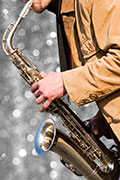
WEDNESDAY, Feb. 19, 2014 (HealthDay News) — The mysterious workings of jazz players’ brains while they improvise music are revealed in a new study.
Researchers used functional MRI scans to monitor the brain activity of 11 male jazz pianists, aged 25 to 56, while they performed spontaneous back-and-forth musical exchanges with each another, which is called “trading fours.”
The MRI scans showed high activity in brain areas typically used to interpret the structure of sentences and phrases, but low activity in areas used to process the meaning of spoken language, according to the Johns Hopkins researchers.
The study authors said their findings indicate that brain areas that process language structure are not limited to spoken language, but are also used to process other types of communication, such as music.
The study was published online Feb. 19 in the journal PLoS One.
“Until now, studies of how the brain processes auditory communication between two individuals have been done only in the context of spoken language,” study senior author Dr. Charles Limb said in a Hopkins news release. “But looking at jazz lets us investigate the neurological basis of interactive, musical communication as it occurs outside of spoken language,” he explained.
“We’ve shown in this study that there is a fundamental difference between how meaning is processed by the brain for music and language,” explained Limb, an associate professor in the department of otolaryngology — head and neck surgery.
Limb is also a musician who holds a faculty appointment at the Peabody Conservatory.
“When two jazz musicians seem lost in thought while trading fours, they aren’t simply waiting for their turn to play,” Limb noted. “Instead, they are using the syntactic areas of their brain to process what they are hearing so they can respond by playing a new series of notes that hasn’t previously been composed or practiced.”
More information
Neuroscience for Kids has more about music and the brain.
Copyright © 2026 HealthDay. All rights reserved.

